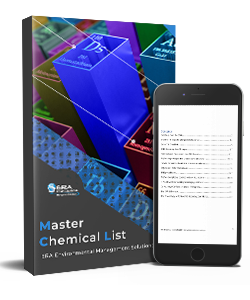ERA has a team of full-time chemical researchers and scientists who monitor the list's regulations and update them constantly. Track extremely hazardous substances and hazardous chemicals.
ERA offers complimentary support to clients with EMS packages to ensure their records, lists of chemicals, and reports reflect up-to-date regulatory requirements. Become compliant with EPA HAP list.
ERA’s platform eliminates countless hours of research and alleviates the stress of reading through extensive government documents. Maintain your chemical inventory with a chemicals hazards list.
Stop purchasing external lists. Wherever your chemical records and calculations go, ERA has you covered.
Your environmental reporting is infinitely more accurate with built-in chemical classifications, thresholds, QA tools, and state codes.
We use vapor pressure, molecular structure, boiling point, and the VOC Exempt List to calculate a chemical's VOC content.
Author secondary container and shipping labels and GHS-compliant SDSs by leveraging all applicable hazards and regulations.
Products appearing in your custom lists indicate their exact composition and linked regulations in one query for ease of use.
ERA tracks more than 3,000 regulations and toxic categories, including all Global Harmonized System (GHS) classifications, European regulations, and federal and state/provincial regulations from the United States and Canada.
TRI under §313 of the Emergency Planning and Community Right-to-Know Act (EPCRA) of 1986, later expanded in the Pollution Prevention Act of 1990.
Section 302 of the U.S. Emergency Planning and Community Right-to-Know Act (42 U.S.C.11002). The list can be found as an appendix to 40 C.F.R. 355.
NPRI under the Canadian Environmental Protection Act, 1999 (CEPA) 46-53.
42 U.S.C. §7401 et seq. (1970) & §112 of the Clean Air Act.
15 U.S.C. §2601 et seq. (1976).
REACH's candidate list of Substances of Very High Concern. The criteria are listed in article 57 of the REACH Regulation.
42 U.S.C. Ch. 82—Solid Waste Disposal 42 U.S.C. §6901 et seq. (1976).
Part 5 of the Canadian Environmental Protection Act, 1999 (CEPA). The DSL is an inventory of substances in the Canadian marketplace published in the Canada Gazette, Part II, in May 1994.
Tier II under §312 of the Emergency Planning and Community Right-to-Know Act (EPCRA) of 1986, SARA Title III.
FEOCs and Dodd-Frank Act Section 1502.
List of substances present in a material or part that remains in a vehicle at point of sale, as prepared by the Global Automotive Stakeholders Group (GASG).
Appendix A of the CFATS regulation (6 CFR Part 27).
40 CFR part 51, §51.100 & 40 CFR 59.203(f).
EPA Act 1992 (Control of VOC Emissions from Petrol Storage & Distribution) Regulations (SI 374 of 1997).
Safe Drinking Water and Toxic Enforcement Act of 1986, a list of chemicals known to the state of California to cause cancer or reproductive toxicity.
Control how regulatory tracking is done by differentiating how chemicals are used and stored on-site.
Create chemical groups and/or limits according to your permits' compliance requirements.
Take a deep dive into the benefits of our list of lists (and saved research hours!) with a case study on using the MCL for reporting and SDS authoring.
